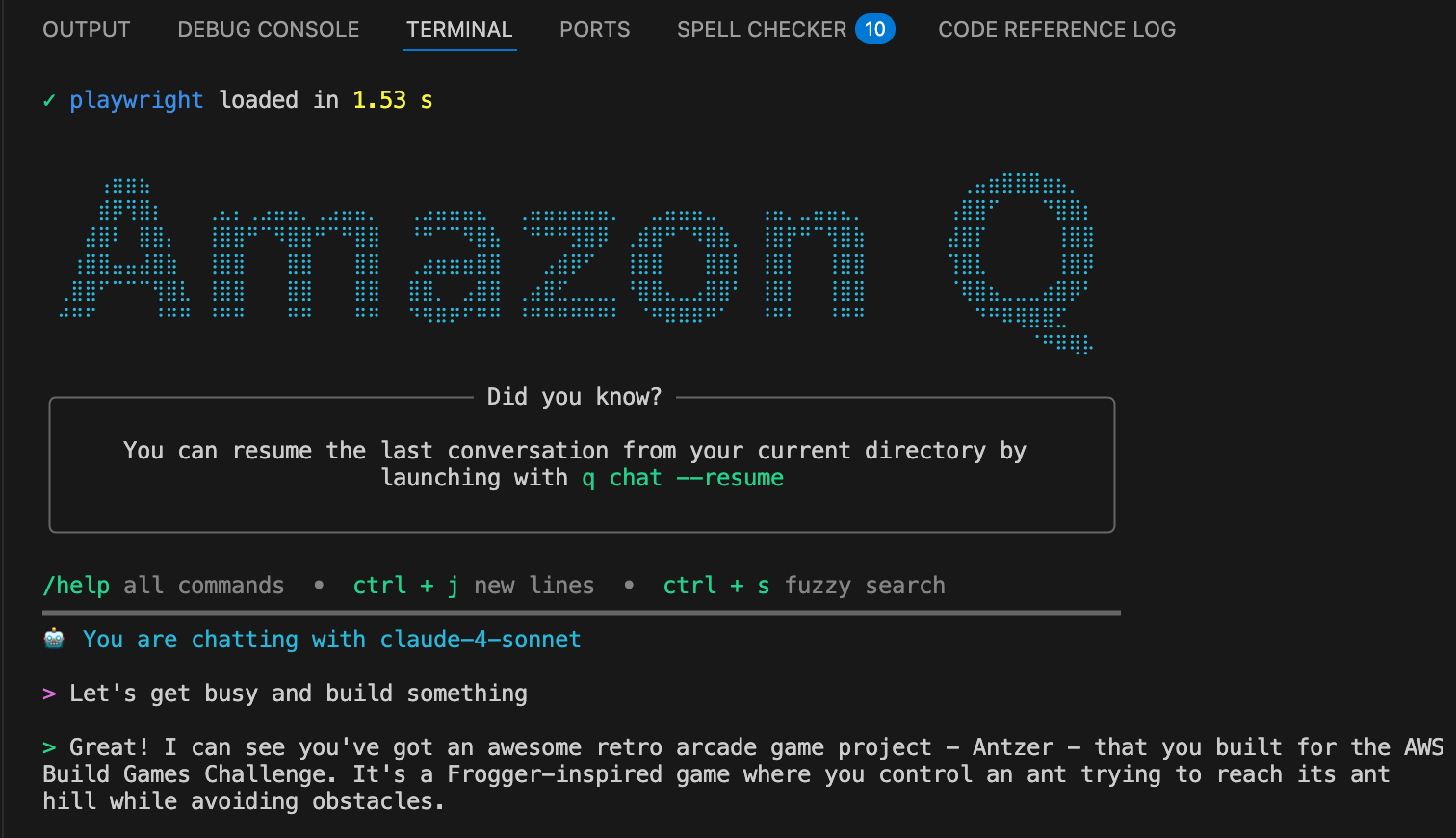Giving AWS Q Developer CLI a second look
Amazon Q Developer has undergone significant evolution since its 2024 debut. After revisiting it for the AWS Build Games Challenge, I was impressed with its improvements. In this article, I highlight why it's worth giving Q CLI a try.

Introduction
The amount of change and innovation in the AI space over the past few years has been nothing short of remarkable. We're experiencing a paradigm shift that will transform the way we work and innovate. With the amount of change we need to embrace, we must also be willing to challenge previously held assumptions and impressions. The following blog post discusses why I recently revisited using Amazon Q Developer and came away with a much more favorable impression than I had nearly a year ago.
Amazon Q Developer was first released in April 2024. The initial version of Q Developer was comparable to other coding assistant tools at the time, such as GitHub Copilot. However, it was limited compared to the tools available in mid-2025. Q Developer required IDE plugins (VS Code, JetBrains, and Visual Studio) and provided users with limited chat capabilities. It wasn't agentic at the time, and it was using now older versions of frontier models (FMs), which were less capable at the time.
I experimented with Q Developer in the Fall of 2024, but I wasn't overly impressed. Its capabilities were limited, the user interface needed improvement, and I didn't find it to be as effective as or superior to other tools, such as GitHub Copilot. My personal experience, coupled with the lack of enthusiasm from the broader development community for Q, made me much less likely to consider using Q for any development tasks.
Personal AI journey
I've been doing what I can to stay abreast of AI Engineering trends. I strive to keep up on major announcements and papers from Anthropic and OpenAI. I've built agentic workflows using Amazon Bedrock and Mastra. I've been reading books such as AI Engineering. Additionally, I actively participate in discussions at work about the evolving AI landscape and how we can effectively integrate AI into our products and workflows to enhance outcomes.
My employer encourages engineers to use AI assistants and provides tools such as GitHub Copilot, Amazon Q, v0, and Claude Code (with a few reasonable guardrails). The AI tool I have most integrated into my professional work is Claude Code. I now use Claude Code daily to help me understand new codebases, plan tasks, maintain code, and implement new features. This terminal-based tool has quickly set my expectations for how developer assistant tools should function, and it continues to improve. Anthropic continuously adds new features, such as support for Model Context Protocol (MCP). I now compare all current and future assistive tools to Claude Code as a baseline.
AWS Build Game Challenge
Amazon Web Services (AWS) sponsored a Build Games Challenge: Build Classics with Amazon Q Developer CLI in July 2025. This challenge encouraged participants to build a classic arcade game using Amazon Q Developer CLI. The challenge sounded fun and was a good opportunity to give Q Developer CLI a second look. When I mentioned the challenge to my son, he had some creative direction, so I gave it a try.
Using the Q Developer CLI and almost exclusively "vibe coding", I created a Frogger-like classic arcade game called Antzer. This challenge encouraged me to give Q Developer another try, and I was impressed with the improved experience and capabilities from when I tried Q in the past. I'll blog more about Antzer in a follow-up post, while the remainder of this post will focus exclusively on Q.
A note on Q branding
Before sharing my experience with Amazon Q Developer CLI, it's worth noting that, similar to Microsoft's Copilot branding, Amazon Q is an umbrella brand for assistive AI products from Amazon Web Services. While all Q branding products are sourced from Amazon, the experience can vary slightly between the chatbot on any AWS web property, Amazon Q Developer in the AWS Console, Amazon Q Business, and Amazon Q Apps. Just because you liked or disliked an experience for one Q product doesn't necessarily mean you'll have an identical experience in a different product under the Q umbrella. Different Q products may use more or less powerful FMs depending on the use case. Similarly, while Amazon Q Developer for IDEs and Amazon Q Developer CLI both utilize the same underlying services and fall under the Q branding, there may be an experience that better suits your preferred flow.
What's new in Amazon Q Developer
Returning to Amazon Q Developer after nearly a year, I was struck by how much it had evolved. The team has added a remarkable number of new features and improvements. Q Developer continues to expand its IDE integrations, now supporting the latest Anthropic models. It works with several popular IDEs, including Visual Studio Code, JetBrains, Eclipse, and Visual Studio. The feature set is extensive, supporting code chats, MCP support, test generation, code reviews, and customizations, among other features. The UI has also undergone notable improvements since the tool's launch in April 2024.
While the IDE progress is impressive, what really caught my attention was the addition of the CLI. The Amazon Q Developer CLI was first released in March 2025. Since its launch, the CLI has received several enhancements, and when combined with its reasonable pricing model, it moves firmly into "must-try" territory. Here are some of the features that stood out to me:
- Model Context Protocol (MCP) Support: MCP is an open standard that allows AI assistants to interact with external tools. While developing Antzer with the Q CLI, I integrated the Playwright MCP server. Adding the Playwright MCP enables me to launch a browser to test parts of the game and reference the latest documentation for some of the game's dependencies directly from the command line. It's impressively easy to add new MCP capabilities to Q CLI, and I consider this one area where the tool shines.
- Granular tool permission control: Q supports robust permissions for its use of tools and commands, allowing you to explicitly grant it capabilities you're comfortable with it having.
- Multiple Model Support: The Q CLI lets you toggle between the latest Anthropic models, including claude-3.5-sonnet, claude-3.7-sonnet, and claude-4-sonnet. I primarily used claude-4-sonnet and never ran into rate limits or throttling during my evaluation.
- Resumable Conversations: You can store and resume conversations across sessions, making it easy to pick up where you left off.
- Image Support: The CLI can read screenshots and images, although it cannot currently generate images.
- Context Management: Like Claude Code, Q CLI shows you how much of the available context window your session is using. You can also manually trigger compaction or clear the context instead of waiting for it to fill up and auto-compact.
- Competitive Pricing: Q CLI pricing is remarkably reasonable compared to alternatives. The Pro Tier offers 1,000 agentic requests and enterprise controls for $19/user/month, while the Pro+ Tier provides 3,000 requests for $39/user/month. Amazon's pricing model for this tool is aggressive, undercutting or matching many competitors while providing a capable product.
If you're a Microsoft Windows user, be aware that the Q Developer CLI currently supports only Linux and macOS (Claude Code has the same limitation as of July 2025). One way to work around this limitation on Windows devices is to use terminal-based assistants in the Windows Subsystem for Linux (WSL2).
Q CLI observations
I found it easy to get started with the Amazon Q Developer CLI Pro Tier using VS Code on my Mac, following the AWS documentation. After installing the Q CLI, I immediately found myself in a familiar working environment. The experience was very similar to what I've experienced using Claude Code. While there are some differences in commands, it wasn't difficult to quickly adapt to them. I didn't perceive any latency or slowness compared to other tools I've used.
Additionally, I didn't encounter any instances of request throttling or rate limiting during my time using Q CLI. In contrast, when using Claude Code in a professional setting, I often encounter situations where my requests are throttled throughout the day. My experience with Q CLI was much better in this regard, but my use of Q CLI has been much more limited.
I don't have any major gripes with Q CLI. It's already very capable, and as highlighted on its GitHub Releases Page, the CLI receives updates at a rapid pace. One feature I missed was the ability to queue multiple commands in a session. When using Claude Code, I find scenarios where it can be helpful to queue multiple commands while a previous command is still being processed. It doesn't appear that Q CLI has similar functionality. I'd expect to see Q CLI gain a similar feature in the future, but this is the one feature I wish it had today.
Q CLI can read and process images. While using the Q CLI to create a game for the AWS Build Games Challenge, it would have been helpful if the Q CLI could generate images, such as sprites, for the game. Although I don't expect a terminal-based assistant to support this feature, it would have been beneficial for hobbyist game development (possibly not an everyday use case).
There are pros and cons to AI assistants integrated into IDEs and terminal-based assistants. Assistants integrated into IDEs can provide deep integrations with warnings and errors, code suggestions, and other IDE capabilities. However, the CLI-based experience is also compelling, making it easier to run sessions in parallel or remotely. With the rapid adoption of MCP servers, CLI-based tools like Q Developer can still integrate with IDEs, offering rich integrations while benefiting from the advantages of CLI-based tools. It will be interesting to see which approach to coding assistance will be the most popular in a few years. No matter which workflow style you prefer, Q Developer supports both.
Final thoughts
If you have never tried Amazon Q Developer or haven't used it for some time, it's worth taking a look. I enjoyed my initial (but limited) experience using the Q CLI for a side project. Amazon offers a generous free tier of Q Developer that you can use without needing to create your own AWS account.
I'll likely continue using Claude Code at work since this tool already has widespread adoption and support within my organization. However, due to Amazon's relatively inexpensive pricing model, I would strongly consider using Q Developer CLI in any new side projects I pursue in the future.
I encourage you to try Q CLI and share your experiences with the broader development community.

